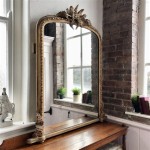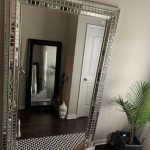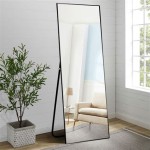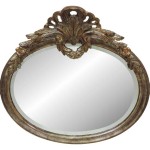Vanity Mirror Frame DIY
A vanity mirror, often the centerpiece of a bathroom or dressing area, can significantly benefit from a custom frame. Building a DIY frame allows for personalized design choices, providing a unique touch and often saving money compared to purchasing a pre-framed mirror. This article will explore various methods and materials suitable for creating a vanity mirror frame.
Before beginning any DIY project, careful planning is essential. Accurate measurements of the mirror are crucial for determining the dimensions of the frame. Adding extra length and width to the mirror's dimensions will account for the frame's overlap. The type of material chosen for the frame will influence the necessary tools and construction techniques. Common materials include wood, metal, and plastic.
Wood offers a classic and versatile option for framing a vanity mirror. Various types of wood, from economical pine to luxurious hardwoods, can be used. The chosen wood should be appropriately sized for the frame's dimensions. A thicker wood provides a more substantial frame, while a thinner wood allows for a sleeker profile. Standard woodworking tools such as a saw, measuring tape, wood glue, and clamps are typically required.
The process of building a wooden frame begins with cutting the wood pieces to the correct lengths. 45-degree angle cuts at the ends of each piece create mitered corners for a professional look. Wood glue and clamps are used to join the pieces, ensuring a secure bond. Finishing nails can provide extra reinforcement. Once the glue has dried, the frame can be sanded smooth and finished with paint, stain, or a clear coat to protect the wood and enhance its appearance.
Metal frames offer a modern and sleek aesthetic. Aluminum or steel are common choices due to their durability and resistance to corrosion. Metal frames can be constructed using metal profiles, which are available in various shapes and sizes. These profiles can be cut to length and joined using metal screws or adhesive. Working with metal often requires specialized tools like a metal saw or grinder.
Alternatively, repurposing existing metal items can provide a unique and eco-friendly framing solution. Old picture frames, decorative metal pieces, or even salvaged metal scraps can be adapted to create a custom frame. This approach often involves more creativity and problem-solving but can result in a truly one-of-a-kind piece.
Plastic offers a lightweight and cost-effective option for a vanity mirror frame. Plastic molding, available in various profiles and colors, can be easily cut and assembled using plastic adhesive. This material is particularly suitable for bathroom environments due to its resistance to moisture. However, plastic may be less durable compared to wood or metal.
Adding decorative elements to the frame can further enhance its visual appeal. Molding, trim, or decorative appliques can be attached to the frame using glue or small nails. These embellishments can be chosen to complement the existing bathroom décor or create a contrasting accent. Consider the overall style of the room when selecting decorative elements.
Attaching the frame to the mirror requires careful consideration. Adhesive is a common method for securing the frame. Mirror adhesive or construction adhesive specifically designed for bonding dissimilar materials is recommended. Applying the adhesive evenly to the back of the frame ensures a secure bond. Care should be taken to avoid getting adhesive on the mirror surface.
Alternatively, clips or brackets can be used to attach the frame. This method offers the advantage of being able to remove the frame easily if necessary. Clips are typically attached to the back of the frame and then secured to the mirror edges. This method may require drilling small holes in the frame for the clips.
Safety should always be a priority during any DIY project. Wearing appropriate safety glasses when using power tools or working with materials that produce dust or debris is essential. Gloves can protect hands from cuts and splinters, and a dust mask is recommended when sanding or working with fine particles. Proper ventilation is also important when using paints, stains, or adhesives containing volatile organic compounds (VOCs).
Choosing the right lighting for a vanity mirror significantly impacts its functionality. Consider the placement of the mirror and the existing lighting in the room. Wall-mounted sconces flanking the mirror provide even illumination. Overhead lighting can also be effective, but ensure it doesn't cast shadows on the face. LED strip lights around the perimeter of the mirror offer a modern and energy-efficient lighting solution.
Maintaining the vanity mirror frame is important for preserving its appearance. Regular dusting with a soft cloth will remove dust and dirt. For wooden frames, occasional polishing with furniture polish can help maintain the wood's shine. Metal frames can be cleaned with a damp cloth and a mild detergent. Avoid using abrasive cleaners or scouring pads, which can scratch the surface of the frame.

Mirror Frame Diy How To Update A Basic Bathroom Our Faux Farmhouse

Diy Framed Bathroom Mirrors Living With Lady

Diy Stick On Mirror Frame Sawdust Sisters

Diy Bathroom Mirror Frame Without Removing Clips Her Happy Home

20 Creative Diy Mirror Frame Ideas To Inspire Your Next Project Bathroom Mirrors Makeover

Diy Bathroom Mirror Frame With Molding The Happier Homemaker

How To Make A Diy Bathroom Mirror Frame Thediyplan

Diy Bathroom Mirror Frame For Under 10 O Hayley Blog

How To Make An Easy Diy Bathroom Mirror Frame Momhomeguide Com
Diy Wood Frame Mirror Farmhouse Industrial Bathroom Joyfully Treasured








